University Mathematics Handbook (2015)
IV. Single-Variable Differential Calculus
Chapter 4. Derivative
4.1 Definition
Let:
![]() be a function defined in the neighborhood of
be a function defined in the neighborhood of ![]() .
.
![]() be a numeric variable added to
be a numeric variable added to ![]() (it can be either positive or negative).
(it can be either positive or negative).
![]() points of the neighborhood of
points of the neighborhood of ![]()
Function ![]() is called differentiable at point
is called differentiable at point ![]() , if there exists a finite limit
, if there exists a finite limit
![]() .
.
Number ![]() is the functions' derivative at point
is the functions' derivative at point ![]() .
.
Other denotations of derivative: ![]() .
.
If we substitute ![]() with the expression
with the expression ![]() , which equals it, we could also write the definition of derivative at
, which equals it, we could also write the definition of derivative at ![]() the following way:
the following way:
![]() .
.
4.2 Tangent Line to a Curve: Geometric Description of the n Derivative
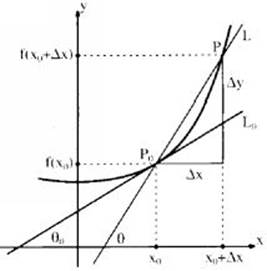
a. A straight line tangent to the graph of function ![]() , if it exists, is the line obtained as the limit of straight lines
, if it exists, is the line obtained as the limit of straight lines ![]() when point
when point ![]() tends to
tends to ![]() (see illustration).
(see illustration).
Equivalently, the tangent straight line ![]() to the graph at
to the graph at ![]() , is the limit of straight line
, is the limit of straight line ![]() when
when ![]() tends to zero.
tends to zero.
b. ![]() is the slope of the straight line tangent to the graph of the function at
is the slope of the straight line tangent to the graph of the function at ![]() , and there holds
, and there holds ![]() when
when ![]() is the angle between the tangent line and the positive direction of the
is the angle between the tangent line and the positive direction of the ![]() -axis.
-axis.
c. The tangent equation is ![]() .
.
4.3 Linear Approximation
a. Function ![]() , defined at a specific neighborhood of point
, defined at a specific neighborhood of point ![]() is differentiable at
is differentiable at ![]() if, and only if, there exists a constant
if, and only if, there exists a constant ![]() and there exists function
and there exists function ![]() , for which holds
, for which holds ![]() such that
such that
![]() .
.
b. If ![]() is differentiable, then
is differentiable, then ![]() for a small enough
for a small enough ![]() , we write
, we write ![]() . That is, the graph of function
. That is, the graph of function ![]() can be approximated to a straight line in a small enough neighborhood of
can be approximated to a straight line in a small enough neighborhood of ![]() .
.
c. If function ![]() is differentiable at
is differentiable at ![]() , then it is continuous at this point.
, then it is continuous at this point.
d. Not any function continuous at ![]() is differentiable at
is differentiable at ![]() .
.
Example: ![]() is continuous at
is continuous at ![]() but not differentiable at
but not differentiable at ![]() .
.
4.4 Derivative Rules
Let ![]() be derivable functions, and
be derivable functions, and ![]() a constant.
a constant.
Therefore:
a. ![]()
b. ![]()
c. ![]()
d. ![]()
![]()
e. ![]()
f. Chain Rule: Derivative Composite Functions
If ![]() is function derivable at
is function derivable at ![]() , and
, and ![]() is function derivable at
is function derivable at ![]() , then the composite function
, then the composite function ![]() is derivable at
is derivable at ![]() , and there holds the equality:
, and there holds the equality:
![]()
In other words, the derivative of composite function ![]() equals to the derivative of
equals to the derivative of ![]() multiplied by the derivative of its inner function
multiplied by the derivative of its inner function ![]() .
.
g. Derivative Inverse Function
If ![]() is invertible function in the neighborhood of
is invertible function in the neighborhood of ![]() , differentiable at
, differentiable at ![]() , and
, and![]() , then is inverse function,
, then is inverse function, ![]() , is differentiable at
, is differentiable at ![]() , and there holds
, and there holds
![]()
h. Derivative functions in the form of ![]() when
when ![]() :
:
Using the logarithm function ![]() , we differentiate:
, we differentiate:
![]()
![]()
Using another way: ![]() and deriving.
and deriving.
i. Deriving a Function Presented in its Parametric Form:
Let ![]() be a function given in the parametric form of
be a function given in the parametric form of ![]() ,
, ![]() (see II.3), when
(see II.3), when ![]() is invertible in the given domain, that is
is invertible in the given domain, that is ![]() , and therefore,
, and therefore, ![]() . Then, from chain rule, there follows:
. Then, from chain rule, there follows:
![]()
4.5 Derivatives of Elementary Functions
|
|
|
|
|
||
|
|
|
9. |
|
|
1. |
|
|
|
10. |
|
|
2. |
|
|
|
11. |
|
|
3. |
|
|
|
12. |
|
|
4. |
|
|
|
13. |
|
|
5. |
|
|
|
14. |
|
|
6. |
|
|
|
15. |
|
|
7. |
|
|
|
16. |
|
|
8. |
4.6 One-Sided Derivatives
a. If function ![]() is defined in a right-handed neighborhood of
is defined in a right-handed neighborhood of ![]() , and there exists limit
, and there exists limit ![]() , it is called the right-hand derivative of
, it is called the right-hand derivative of ![]() at
at ![]() , and is denoted by
, and is denoted by ![]() .
.
b. The left-handed derivative of ![]() at
at ![]() is
is
![]() .
.
c. Example: The one-sided derivatives of ![]() are
are
![]() .
.
d. The function ![]() is differentiable at
is differentiable at ![]() if, and only if, its one-sided derivatives at
if, and only if, its one-sided derivatives at ![]() exist are equal.
exist are equal.
e. If the derivative at ![]() exists, then
exists, then ![]() .
.
f. Function ![]() is differentiable in close interval
is differentiable in close interval ![]() , if it is differentiable at
, if it is differentiable at ![]() and its one-sided derivatives
and its one-sided derivatives ![]() ,
, ![]() exist.
exist.
4.7 High-Order Derivatives
a. Let ![]() be a function derivable at interval
be a function derivable at interval ![]() . If we derivative it at all points of the interval, we'll have a new function
. If we derivative it at all points of the interval, we'll have a new function ![]() , which, too, is defined in all interval
, which, too, is defined in all interval ![]() . The function
. The function ![]() is the first derivative of
is the first derivative of ![]() in interval
in interval ![]() .
.
If function ![]() , also, is derivable in interval
, also, is derivable in interval ![]() , we will denote its derivative as
, we will denote its derivative as ![]() .
. ![]() is defined on all interval
is defined on all interval ![]() , and is called the second derivative of
, and is called the second derivative of ![]() . Similarly, we define the third derivative, forth derivative, and so on.
. Similarly, we define the third derivative, forth derivative, and so on.
In general, if function ![]() can be derivated
can be derivated ![]() times, in interval
times, in interval ![]() , then, the last function in the set of
, then, the last function in the set of ![]() derivatives is denoted by
derivatives is denoted by ![]() or by
or by ![]() , and is called the
, and is called the ![]() -th derivative of
-th derivative of ![]() .
.
Another denotation of ![]() -th derivative is that of Leibniz:
-th derivative is that of Leibniz: ![]() .
.
b. Leibniz formula
Let ![]() and
and ![]() be functions differentiable
be functions differentiable ![]() times at
times at ![]() . Then:
. Then:
![]()
![]()
![]()
![]()
when ![]() .
.
c. Examples:
1. ![]()
2. ![]()
3. ![]()
4. ![]()
4.8 Differentials
a.
1. The entity ![]() is called the differential of
is called the differential of ![]() at point
at point ![]() . As opposed to
. As opposed to ![]() variable, which does not depend on any other entity, the
variable, which does not depend on any other entity, the ![]() variable depends on
variable depends on ![]() and
and ![]() .
.
Another basic essential difference between ![]() and
and ![]() is that while
is that while ![]() , usually,
, usually, ![]() . The illustration shows the geometric description of each of these entities, and the way the
. The illustration shows the geometric description of each of these entities, and the way the ![]() entity is related to
entity is related to ![]() entity. These two entities tend to unite as
entity. These two entities tend to unite as ![]() decreases.
decreases.
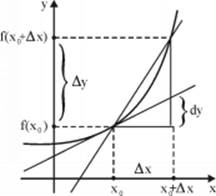
2. If ![]() , then
, then ![]() .
.
b. Higher-Order Differentials
![]() is a second-order differential.
is a second-order differential.
![]() is an
is an ![]() -th order differential.
-th order differential.
4.9 Differential Calculus Basic Theorems
a.
1. Fermat’s Theorem
Let ![]() be a function defined on open interval
be a function defined on open interval ![]() and differentiable at inner point
and differentiable at inner point ![]() . If
. If ![]() attains a maximum or a minimum value at
attains a maximum or a minimum value at ![]() , then
, then ![]() .
.
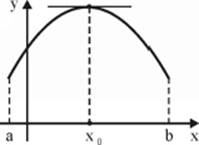
2. The Geometric Meaning of Fermat's Theorem
If ![]() attains a maximum or a minimum value at
attains a maximum or a minimum value at ![]() , and if, in the neighborhood of
, and if, in the neighborhood of ![]() , its graph has a “hill,” then, the straight line tangent to
, its graph has a “hill,” then, the straight line tangent to ![]() at this point have to parallel to the
at this point have to parallel to the ![]() -axis. That is, the derivative at
-axis. That is, the derivative at ![]() should be zero.
should be zero.
b. Rolle's Theorem
Let ![]() be a function defined at close interval
be a function defined at close interval ![]() , and there holds the following:
, and there holds the following:
1. ![]() is continuous at close interval
is continuous at close interval ![]() .
.
2. ![]() is differentiable at open interval
is differentiable at open interval ![]() .
.
3. ![]() .
.
Then, there is a ![]() , such that
, such that ![]() .
.
Geometrically, Rolle's theorem means that if a continuous and differentiable function at a close interval has equal values at the extreme points of the interval, then there exists at least one point within the interval where the straight line tangent to the graph is parallel to the ![]() -axis. But sometimes, there is more than one such point.
-axis. But sometimes, there is more than one such point.
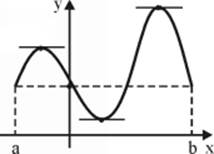
c. Lagrange's Mean-Value Theorem
1. If ![]() is a function continuous at close interval
is a function continuous at close interval ![]() and differentiable at open interval
and differentiable at open interval ![]() , then there is at least one point c,
, then there is at least one point c, ![]() such that
such that
![]()
2. Geometrically, the theorem means that if ![]() is a function continuous at close interval
is a function continuous at close interval ![]() and differentiable at open interval
and differentiable at open interval ![]() , then there exists a point on the graph where the straight line tangent to the graph in it is parallel to the straight line passing through the extreme points of the graph. The illustration shows the graph of a function with three such points.
, then there exists a point on the graph where the straight line tangent to the graph in it is parallel to the straight line passing through the extreme points of the graph. The illustration shows the graph of a function with three such points.
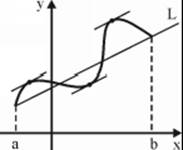
3. Another form of Lagrange's theorem: if ![]() is a function differentiable at interval
is a function differentiable at interval ![]() , then, for all
, then, for all ![]() , such that
, such that ![]() , there exists a real number
, there exists a real number ![]() ,
, ![]() , such that
, such that
![]() .
.
d. Cauchy's Mean-Value Theorem
1. Let ![]() and
and ![]() be two functions continuous at close interval
be two functions continuous at close interval ![]() and differentiable at open interval
and differentiable at open interval ![]() , and, in addition,
, and, in addition, ![]() for all
for all ![]() . Then, there is at least one point c,
. Then, there is at least one point c, ![]() , such that
, such that
![]()
2. If ![]() and
and ![]() are functions continuous and differentiable in the neighborhood of
are functions continuous and differentiable in the neighborhood of ![]() , and,
, and, ![]() for all
for all ![]() in that neighborhood, then, for every
in that neighborhood, then, for every ![]() , (small enough) such that
, (small enough) such that ![]() is in the given neighborhood, there exists a real number
is in the given neighborhood, there exists a real number ![]() ,
, ![]() , such that
, such that
![]()
e. Darboux's Mean-Value Theorem
1. If function ![]() is differentiable at close interval
is differentiable at close interval ![]() , then for every
, then for every ![]() between
between ![]() and
and ![]() there exists an
there exists an ![]() such that
such that ![]() . In other words, if
. In other words, if ![]() is differentiable at the close interval
is differentiable at the close interval ![]() , then, the image of
, then, the image of ![]() is an interval.
is an interval.
2. If function ![]() is differentiable at close interval
is differentiable at close interval ![]() , then its derivative
, then its derivative ![]() is not necessarily continuous and therefore is not differentiable.
is not necessarily continuous and therefore is not differentiable.
If ![]() is not continuous at
is not continuous at ![]() , then it is a second-type discontinuity.
, then it is a second-type discontinuity.
Example: The derivative of  is function
is function  , which is not continuous at
, which is not continuous at ![]() , since the limit
, since the limit ![]() does not exist.
does not exist.
4.10 L'Hopital's Rules
a. Let ![]() and
and ![]() be functions differentiable in the neighborhood of
be functions differentiable in the neighborhood of ![]() , except, possibly, at
, except, possibly, at ![]() . Suppose that:
. Suppose that:
1. There exists the limit ![]()
or ![]() .
.
2. ![]() for all
for all ![]() in the neighborhood of
in the neighborhood of ![]() .
.
3. There exists the limit ![]() .
.
Then, there also exists the limit ![]() , and there holds that
, and there holds that ![]() .
.
b. If functions ![]() and
and ![]() are differentiable in infinite interval (a,∞), and
are differentiable in infinite interval (a,∞), and
1. The limits ![]() exist
exist
2. ![]() for all
for all ![]()
3. The limit ![]() exists.
exists.
Then, the limit ![]() also exists, and there holds
also exists, and there holds ![]() .
.
4.11 Taylor's Formula
a. If function ![]() is differentiable
is differentiable ![]() times in the neighborhood of
times in the neighborhood of ![]() , and
, and ![]() is a point in this neighborhood, then there exists a point
is a point in this neighborhood, then there exists a point ![]() , between
, between ![]() and
and ![]() , such that
, such that
![]()
![]()
when ![]() is Lagrange remainder.
is Lagrange remainder.
If, we substitute ![]() in Taylor's formula, we obtain Maclaurin formula:
in Taylor's formula, we obtain Maclaurin formula:
![]()
b. Peano Remainder Formula
![]()
c. Cauchy Remainder Formula
![]()
d. Examples:
1. ![]()
2. ![]()
3. ![]()
4. ![]() ,
, ![]()
4.12 Investigations of Function
a. Intervals of Increase and Decrease of a Function:
1. Differentiable Function ![]() is constant in interval
is constant in interval ![]() if, and only if,
if, and only if, ![]() for all
for all ![]() .
.
2. ![]() is not decreasing in interval
is not decreasing in interval ![]() if, and only if,
if, and only if, ![]() .
.
3. ![]() is not increasing in interval
is not increasing in interval ![]() if, and only if,
if, and only if, ![]() .
.
4. ![]() is increasing in interval
is increasing in interval ![]() if, and only if,
if, and only if, ![]() for all
for all ![]() .
.
5. ![]() is decreasing in interval
is decreasing in interval ![]() if, and only if,
if, and only if, ![]() , for all
, for all ![]() .
.
Note: Propositions 4 and 5 are true one-way only. That is, if ![]() is differentiable and monotone increasing in interval
is differentiable and monotone increasing in interval ![]() , then, it doesn’t necessarily follow that
, then, it doesn’t necessarily follow that ![]() for all points of
for all points of ![]() . For example,
. For example, ![]() is increasing in
is increasing in ![]() yet
yet ![]() .
.
b. Local Maximum and Minimum Values:
1. ![]() has a local minimum value at
has a local minimum value at ![]() if there exists a definite neighborhood of
if there exists a definite neighborhood of ![]() where there holds
where there holds ![]() for all
for all ![]() in this neighborhood.
in this neighborhood.
2. ![]() has a local maximum value at
has a local maximum value at ![]() if there exists a definite neighborhood of
if there exists a definite neighborhood of ![]() where there holds
where there holds ![]() for all
for all ![]() in this neighborhood.
in this neighborhood.
Point ![]() , which is a local minimum or maximum, is called a local extreme point or local extremum of
, which is a local minimum or maximum, is called a local extreme point or local extremum of ![]() .
.
3. A necessary condition for the existence of local extremum: If function ![]() is differentiable in then neighborhood of extreme point
is differentiable in then neighborhood of extreme point ![]() , then
, then ![]() .
.
4. ![]() is called a critical point of
is called a critical point of ![]() if
if ![]() . Critical points and points in which
. Critical points and points in which ![]() is not differentiable are called suspected extremum points.
is not differentiable are called suspected extremum points.
c. Sufficient Condition of Extremum
1. Let ![]() be a function defined in the neighborhood of
be a function defined in the neighborhood of ![]() . The sign of
. The sign of ![]() is said to change from negative to positive at
is said to change from negative to positive at ![]() , if there exists a neighborhood
, if there exists a neighborhood ![]() , such that for all
, such that for all ![]() in the interval
in the interval ![]() ,
, ![]() , and, for all
, and, for all ![]() in the interval
in the interval ![]() ,
, ![]() . The same way we determine when the sign of
. The same way we determine when the sign of ![]() changes from negative to positive at
changes from negative to positive at ![]() .
. ![]() maintains its sign in point
maintains its sign in point ![]() , if there exists a neighborhood
, if there exists a neighborhood ![]() where
where ![]() for all
for all ![]() of, or
of, or ![]() for all
for all ![]() in this neighborhood.
in this neighborhood.
2. First Derivative Test
Let ![]() be a suspected extremum point of function
be a suspected extremum point of function ![]() , if
, if ![]() is continuous in
is continuous in ![]() , and is differentiable in the neighborhood of
, and is differentiable in the neighborhood of ![]() , except, possibly, in
, except, possibly, in ![]() , then follows:
, then follows:
a) If the sign of ![]() changes from negative to positive in
changes from negative to positive in ![]() , then
, then ![]() is a local minimum of
is a local minimum of ![]() .
.
b) If the sign of ![]() changes from positive to negative in
changes from positive to negative in ![]() , then
, then ![]() is a local maximum of
is a local maximum of ![]() .
.
c) If ![]() maintains its sign at
maintains its sign at ![]() , then
, then ![]() is not a local extremum of
is not a local extremum of ![]() .
.
3. Second Derivative Test
If ![]() is a critical point of
is a critical point of ![]() and
and ![]() is twice differentiable, then follows:
is twice differentiable, then follows:
a) If ![]() then
then ![]() is a local minimum of
is a local minimum of ![]() .
.
b) If ![]() then
then ![]() is a local maximum of
is a local maximum of ![]() .
.
c) If ![]() , then we cannot conclude on
, then we cannot conclude on ![]() from this method, and we should examine it using the previous method or other ways.
from this method, and we should examine it using the previous method or other ways.
d. Absolute Maximum and Minimum in Domain ![]()
1. Point ![]() is an absolute maximum of
is an absolute maximum of ![]() in domain
in domain ![]() if, for all
if, for all ![]() , there holds
, there holds ![]() .
.
2. Point ![]() is called absolute minimum of
is called absolute minimum of ![]() in domain
in domain ![]() if, for all
if, for all ![]() , there holds
, there holds ![]() .
.
e. Concavity and Points of Inflection
1. Function ![]() is concave down on interval
is concave down on interval ![]() , if, for all
, if, for all ![]() and for all
and for all ![]() , there holds
, there holds
![]()
2. Function ![]() is concave up on interval
is concave up on interval ![]() , if, for all
, if, for all ![]() and for all
and for all ![]() , there holds
, there holds
![]()
3. If function ![]() is differentiable on
is differentiable on ![]() , and there exists an neighborhood of
, and there exists an neighborhood of ![]() where the graph of the function is under the tangent line to the graph at that point, that is, there exists an
where the graph of the function is under the tangent line to the graph at that point, that is, there exists an ![]() such that, for all
such that, for all![]() which holds
which holds ![]() there holds
there holds ![]() , Then
, Then ![]() is concave down on
is concave down on ![]() .
.
4. Function ![]() is concave up on
is concave up on ![]() , if there exists a neighborhood of
, if there exists a neighborhood of ![]() where the graph of
where the graph of ![]() is above the tangent line to the graph at that point.
is above the tangent line to the graph at that point.
5. Function ![]() is concave down on open interval
is concave down on open interval ![]() , if it is concave down on any point of the interval. Similarly, we define concavity up on interval
, if it is concave down on any point of the interval. Similarly, we define concavity up on interval ![]() .
.
6. Sufficient Condition of Concavity
Let ![]() be a function twice differentiable on interval
be a function twice differentiable on interval ![]() , then:
, then:
a) If, for all ![]() in interval
in interval ![]() ,
, ![]() , then
, then ![]() is concave up in interval
is concave up in interval ![]() .
.
b) If, for all ![]() in interval
in interval ![]() ,
, ![]() , then
, then ![]() is concave down in interval
is concave down in interval ![]() .
.
f. Points of Inflection
Point ![]() is the point of inflection of function
is the point of inflection of function ![]() , if
, if ![]() is continuous at
is continuous at ![]() and there exists a neighborhood
and there exists a neighborhood ![]() such that the concavity directions of the function in intervals
such that the concavity directions of the function in intervals ![]() ,
, ![]() are opposite. That is, if
are opposite. That is, if ![]() is concave down in interval
is concave down in interval ![]() and concave up in interval
and concave up in interval ![]() , or vise versa.
, or vise versa.
g. Asymptotes
1. The straight line ![]() is a vertical asymptote of function
is a vertical asymptote of function ![]() , which is defined in a right-handed or left-handed neighborhood of point
, which is defined in a right-handed or left-handed neighborhood of point ![]() , except, possibly,
, except, possibly, ![]() , if, at least one of the limits
, if, at least one of the limits ![]() ,
, ![]() equals to
equals to ![]() or
or ![]() .
.
2. The geometric meaning of the existence of vertical asymptote is that the graph of ![]() , near point
, near point ![]() , gets steep and very close to the straight line
, gets steep and very close to the straight line ![]() , but doesn't contact it.
, but doesn't contact it.
3. The straight line ![]() is an oblique asymptote of
is an oblique asymptote of ![]() at
at ![]() , when
, when ![]() .
.
If ![]() , the asymptote is also called a horizontal asymptote of
, the asymptote is also called a horizontal asymptote of ![]() , since
, since ![]() is a horizontal straight line.
is a horizontal straight line.
4. The straight line ![]() is an oblique asymptote at
is an oblique asymptote at ![]() , if
, if
![]()
5. If ![]() is a function defined in interval
is a function defined in interval ![]() , and if the limits
, and if the limits ![]() exist, then the straight line
exist, then the straight line ![]() is the unique oblique asymptote of
is the unique oblique asymptote of ![]() when
when ![]() .
.
6. If ![]() is a function defined in interval
is a function defined in interval ![]() , and if the limits
, and if the limits ![]() , then the straight line
, then the straight line ![]() is the unique oblique asymptote of
is the unique oblique asymptote of ![]() in
in ![]() .
.
h. Investigation of a Function
Main stages in investigation of a function:
1. The domain of the function
2. The intersection points of the graph with the coordinate axes
3. Extreme
4. Intervals of increase and decrease
5. Intervals of concavity
6. Points of inflection
7. Asymptotes
8. Gathering the data in a table
9. Drawing then graph of the function